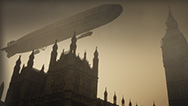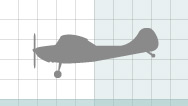Flying Cow Intestines
- Posted 05.15.14
- NOVA
During World War I, the Germans bombed London from giant airships, called Zeppelins, filled with hydrogen. But, how did they contain all that hydrogen gas? They created enormous balloons made of cow intestines. In fact, it took a quarter of a million cows to make just one Zeppelin.
Transcript
Flying Cow Intestines
Published: May 15, 2014
NARRATOR: To make the leak-proof bags that held the hydrogen, the airship pioneers needed a material that was light and strong and in plentiful supply.
They found it in an unlikely place: inside a cow.
HUGH HUNT: One of the things that I found so fascinating is the story of what these bags are made of. And they were made of this stuff, which, well, you look at this and you kind of think, "Well, is it paper? What is it?" It's the intestinal lining of a cow.
MAN IN GREY SHIRT: That's extraordinary, isn't it? I've never actually seen this…
ERIC GROVE: I haven't either.
MAN IN GREY SHIRT: …before.
ERIC GROVE: [inaudible] I've only read about it.
HUGH HUNT: And it's…
ERIC GROVE: Yes, it's very tough.
HUGH HUNT: …it's tough.
NARRATOR: At this processing plant in Middlesbrough, England, animal intestines arrive by the barrel-load from the slaughterhouse. Incredibly, this stuff was the raw material for zeppelins.
Hugh investigates, reluctantly.
HUGH HUNT: I'm not sure I should have had a cooked breakfast this morning.
NARRATOR: These intestines are used to make sausage skins, just as they were in Germany during the First World War. Today, the guts are processed on an industrial scale, as factory owner John Weschenfelder explains.
JOHN WESCHENFELDER (W. Weschenfelder & Sons Sausage Making Supplies): This machine's taking grass out. It's taking the sheets…
HUGH HUNT: It's taking what out?
JOHN WESCHENFELDER: Grass.
HUGH HUNT: Oh, grass.
JOHN WESCHENFELDER: [EXPETIVE DELETED] …go through a second machine.
HUGH HUNT: Yeah?
JOHN WESCHENFELDER: The second machine's taking mucus out.
HUGH HUNT: All right.
JOHN WESCHENFELDER: The final machine is what we call the finishing machine.
NARRATOR: Hugh wants to find out how narrow tubes can be turned into enormous balloons.
HUGH HUNT: And that is what we make balloons out of?
NARRATOR: Sensibly, the zeppelin builders started with the biggest piece of cow gut they could find.
JOHN WESCHENFELDER: This is the appendix. Cows…
HUGH HUNT: Right, I see.
JOHN WESCHENFELDER: It's called the "blind end" of the stomach.
HUGH HUNT: So, that's a cow's appendix.
NARRATOR: The thin membrane that lines the cow's appendix is made of collagen, the same stuff that forms skin and bones. It has some very special properties.
JOHN WESCHENFELDER: See its texture?
HUGH HUNT: Look at that!
JOHN WESCHENFELDER: It's like a balloon.
HUGH HUNT: It's very strong.
JOHN WESCHENFELDER: If we get some warm water and just dip it in the warm water now…
NARRATOR: Somehow, the German zeppelin builders stumbled across the technique for joining the membranes together using nothing more than water.
HUGH HUNT: Like this?
JOHN WESCHENFELDER: Yeah. If we get it over the edges, it'll actually hold on the edges.
HUGH HUNT: Right.
JOHN WESCHENFELDER: If I get another one and just overlap it…
NARRATOR: Using this magical process, the Germans were able to piece together their gigantic gasbags from small strips of cow gut.
JOHN WESCHENFELDER: What we need to do now is leave that to dry.
So we did one, and after two hours, this is what we found.
You can see this, that where it's joined there, it's just melted, blended together, and it's absolutely perfect.
HUGH HUNT: That won't come apart?
JOHN WESCHENFELDER: Just the moisture has bonded it together.
HUGH HUNT: But I want to understand why.
NARRATOR: To find out, Hugh takes the sample back to Cambridge University and asks his colleague, collagen expert Michelle Oyen.
They take a close look at the overlapping joint under a scanning electron microscope.
DR. MICHELLE OYEN (Collagen Expert): Oh, wow.
HUGH HUNT: Golly.
MICHELLE OYEN: We've got all of these tiny, tiny, tiny little fibrils going across the interface here, all the fibers.
HUGH HUNT: All the fibers.
But if this is the interface, what's extraordinary is just how much inter-tangling and intertwining has happened. This doesn't look like just two sheets of anything. It looks like something really quite…
MICHELLE OYEN: Structurally complicated.
HUGH HUNT: …structurally complicated.
NARRATOR: The entwined fibers bind the two sheets of collagen together.
When the collagen is wet, the fibers at the interface slide across one another without sticking, but as they dry out, they become tacky and adhere to one another.
MICHELLE OYEN: Our ancestors were very crafty in the fact that they figured out how to use this natural polymer for other uses. Doesn't surprise me at all.
NARRATOR: Cow gut was a zeppelin's secret weapon, but it took the intestines of more than a quarter of a million animals to make just one airship. The material was so precious to the war effort that, for a time, sausage-making in Germany was verboten.
This is an excerpt from the NOVA program "Zeppelin Terror Attack."
Credits
- PRODUCED BY
- Ian Duncan And Johnny Shipley
- WRITTEN AND DIRECTED BY
- Ian Duncan
- EDITED BY
- Paul Shepard
- PRODUCTION MANAGER
- Lizzie Narey
- DIRECTOR OF PHOTOGRAPHY
- Mike Coles
- SOUND RECORDIST
- Keith Rodgerson
- ORIGINAL MUSIC BY
- Alasdair Reid
- NARRATOR
- Jay O. Sanders
- VISUAL EFFECTS
- Fluid Pictures
- 2D GRAPHICS
- Dinnick & Howells
- PRODUCTION DESIGNERS
- Jamie Andrews
Jason Cole - SFX MAKEUP
- Hannah Wing
- PRODUCTION COORDINATOR
- Rebecca Coleman
- ASSISTANT PRODUCER
- Catherine Watling
- ASSOCIATE RESEARCHER
- Shraddha Chakradhar
- ONLINE EDITOR
- Marc Corrance
- COLORIST
- Vicki Matich
- AUDIO MIX
- Matt Skilton
- PRODUCTION ADMINISTRATION
- Susan Harvard
- HEAD OF PRODUCTION
- Birte Pedersen
- ARCHIVAL MATERIAL
- Critical Past
English Heritage
Footage Farm
Images of War
Imperial War Museum
The National Archives
Raf Museum
Topfoto - SPECIAL THANKS
- Anne Bahnweg, Cambridge University
Dr. June Barrow-Green
Defence Academy of the UK
Dr. Guy Finch
David Kirch
Dr. Michelle Oyen, Cambridge University
Dr. David Sharp, Open University
Martin Taylor
ZLT Zeppelin Luftschifftechnik GmbH & Co KG - NOVA SERIES GRAPHICS
- yU + co.
- NOVA THEME MUSIC
- Walter Werzowa
John Luker
Musikvergnuegen, Inc. - ADDITIONAL NOVA THEME MUSIC
- Ray Loring
Rob Morsberger - CLOSED CAPTIONING
- The Caption Center
- POST PRODUCTION ONLINE EDITOR
- Michael H. Amundson
- DIRECTOR OF PR
- Jennifer Welsh
- PUBLICITY
- Eileen Campion
Eddie Ward - SENIOR RESEARCHER
- Kate Becker
- NOVA ADMINISTRATOR
- Kristen Sommerhalter
- PRODUCTION COORDINATOR
- Linda Callahan
- PARALEGAL
- Sarah Erlandson
- TALENT RELATIONS
- Scott Kardel, Esq.
Janice Flood - LEGAL COUNSEL
- Susan Rosen
- DIRECTOR OF EDUCATION
- Rachel Connolly
- DIGITAL MANAGING PRODUCER
- Kristine Allington
- SENIOR DIGITAL EDITOR
- Tim De Chant
- DIRECTOR OF NEW MEDIA
- Lauren Aguirre
- DEVELOPMENT ASSOCIATE
- Lisa Leombruni
- UNIT MANAGER
- Ariam McCrary
- POST PRODUCTION ASSISTANT
- Brittany Flynn
- POST PRODUCTION EDITOR
- Rebecca Nieto
- POST PRODUCTION MANAGER
- Nathan Gunner
- COMPLIANCE MANAGER
- Linzy Emery
- BUSINESS MANAGER
- Elizabeth Benjes
- DEVELOPMENT PRODUCER
- David Condon
- PROJECT DIRECTOR
- Pamela Rosenstein
- COORDINATING PRODUCER
- Laurie Cahalane
- SENIOR SCIENCE EDITOR
- Evan Hadingham
- SENIOR PRODUCERS
- Julia Cort
Chris Schmidt - SENIOR SERIES PRODUCER
- Melanie Wallace
- MANAGING DIRECTOR
- Alan Ritsko
- SENIOR EXECUTIVE PRODUCER
- PAULA S. APSELL
Produced by Windfall Films Ltd. for NOVA/WGBH Boston in association with Channel 4 and National Geographic Channels
© 2014 Windfall Films Ltd.
All rights reserved
Additional Material © 2014 WGBH Educational Foundation
This program was produced by WGBH, which is solely responsible for its content.
IMAGE
- (Cow)
- © WGBH Educational Foundation 2014
Related Links
-

Zeppelin Terror Attack
Discover how the first civilian bombing unfolded as Germany's Zeppelins rained fiery terror on London in World War I.
-

The Aerial Arms Race
See how fighter planes evolved during World War I, the first major conflict to engage aerial warfare.
-

Lift and Drag
What are lift and drag? And how do they work?
-

Clothing from Slime?
Super-strong hagfish slime might become the fabric of the future.

